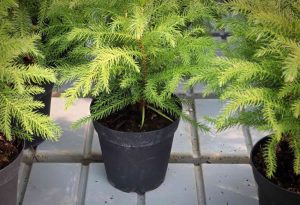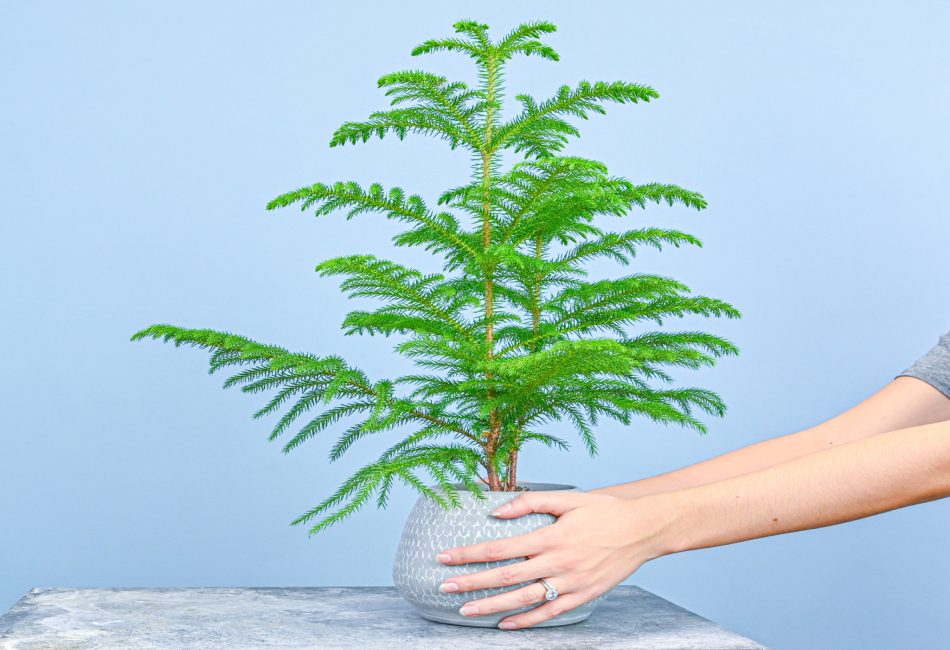Houseplants make a room look nice and can help clean the air. To stay healthy, they need light, water, and care. Some plants need a lot of sunlight, while others can grow in low light. Taking care of houseplants can be a fun and relaxing hobby.
The Norfolk Island Pine (Araucaria heterophylla) is a popular evergreen tree native to Norfolk Island, a small island in the Pacific Ocean between Australia and New Zealand. It belongs to the Araucariaceae family and is a popular indoor plant due to its vibrant green leaves and uniform, arranged branches.
Growcycle provides a complete guide for Norfolk Pine care. It helps new and experienced plant lovers to grow this beautiful plant in their homes and enjoy its natural beauty.
Characteristics of Norfolk Island Pine
The Norfolk Island Pine is a beautiful and distinctive evergreen tree with a uniform shape and soft, needle-shaped leaves. Here are its main characteristics:
● Tree Structure
The Norfolk Pine has a tall, straight trunk with evenly spaced horizontal branches that form distinct clumps. As the branches grow outward in layers, they create a stylish, pyramidal shape, making it a stunning choice for landscape and indoor settings.
● Growth Pattern
The Norfolk Island Pine, which can grow to 200 feet in its natural habitat, is a prominent element of the island’s landscape. However, when grown indoors as a houseplant, its growth is significantly restricted. It can reach 3 to 8 feet, depending on pot size and care.
● Leaves and Needles
When the tree is young, its soft, needle-like leaves are bright green, and their color slowly deepens as it develops. It is a popular indoor plant because its needles are softer to the touch than true pines. The leaves’ fine, feathery texture further increases its delicate and lush appearance.
● Bark and Cones
The bark of the Norfolk Island Pine is light brown to grayish with a slightly textured, curved appearance. While the tree produces large, rounded cones in its native environment, it rarely develops cones indoors. In the wild, these cones contain edible seeds similar to pine nuts, though they are not commonly harvested.

Benefits of Norfolk Island Pine
The Norfolk Island Pine is a beautiful addition to indoor spaces. It has several benefits, including:
- Aesthetic Appeal: The Norfolk Island Pine is grown primarily for its decorative appeal. Its fantastic structure adds charm to any space, whether as an indoor plant or an established outdoor tree. The pine is also frequently used as an eco-friendly holiday decoration, such as a Christmas tree.
- Air Purification: Like many other houseplants, the Norfolk Island Pine can purify indoor air by removing toxic greenhouse gases and volatile organic substances. Its lush green leaves contribute to a cleaner, healthier atmosphere.
- Health Benefits: This houseplant can increase productivity, lower stress levels, and improve mood. Because of its friendly green leaves, the Norfolk Island Pine is an excellent addition to homes and workplaces.
- Environmental Benefits: When planted outdoors, this tree offers a home for birds and other wildlife and helps stop soil erosion. It also helps control climate change by capturing carbon dioxide and participating in the storage of carbon.
Care Tips for Norfolk Island Pine
Growing a Norfolk Island Pine requires specific care to keep it healthy and thriving. Here is a detailed guide to its care requirements:
1. Light Requirements
It can survive some direct sunlight but loves bright, indirect light. Place it indoors near a window facing south or east so it gets at least four to six hours of light each day. If natural light is insufficient, use a grow light to avoid uneven or slow growth.
2. Temperature and Humidity
It flourishes in temperatures between 60°F and 75°F and is not cold-tolerant. Avoid exposure to temperatures below 50°F. Requires high humidity to maintain healthy foliage. In dry climates, humidity can be increased by using a humidifier and spraying the plant occasionally. Placing a tray of water with stones beneath the pot boosts moisture levels.
3. Watering
Keep the soil a little wet but not saturated. Water when the upper layer of soil feels dry. Underwatering can cause needle browning and drying, while overwatering may lead to root rot. Use room-temperature water to prevent root shock.

4. Soil Requirements
Prefers well-draining, slightly acidic soil. A good mix includes potting soil, peat moss, and perlite for aeration. Avoid heavy clay-based soils, which retain too much moisture.
5. Fertilizing
During spring and summer growing season, fertilize every 4 to 6 weeks using a balanced liquid fertilizer (10-10-10) diluted to half strength. Reduce application in fall and winter when growth slows down.
6. Pruning and Maintenance
Dead or brown are the only branches that need to be cut to keep shape. A tree’s natural, symmetrical growth may be impacted if the main stem is cut.
7. Repotting
To encourage continued growth, replant young trees every two to three years. Every time the tree grows deep roots, select a larger pot. Ensure that holes in the pot keep water from building up.
8. Seasonal Care
In winter, it requires less water, so water it less frequently while keeping the humidity high to avoid dryness. Avoid placing the plant near heaters or cold drafts. When transferring a plant outdoors, gradually expose it to outdoor conditions because sudden exposure to direct sunlight can result in sunburn.
FAQs
Is Norfolk Island Pine safe for pets?
If eaten, Norfolk Island Pine can be mildly toxic to cats and dogs, causing stomach upset. Keep it away from pets.
Does Norfolk Island Pine need to be repotted often?
Repot every 2 to 3 years or when roots start coming out of the drainage holes. Choose a pot that is only slightly larger than the current one.
Can Norfolk Island Pine be pruned?
Pruning is rarely required, but dead or damaged branches can be trimmed. The central trunk does not regrow, so do not cut it.
The Bottom Line
Norfolk Island Pine is a beautiful plant that adds beauty and environmental benefits to any space. It requires specific care, including adequate light, proper watering, and humidity maintenance. Visit Growcycle to learn more about care tips for growing this plant.
